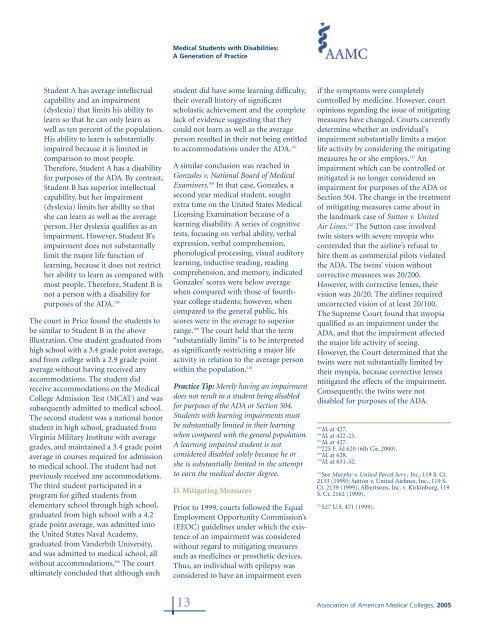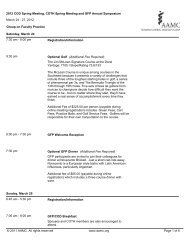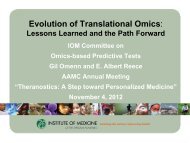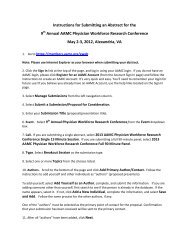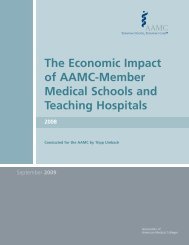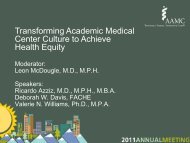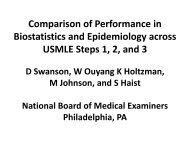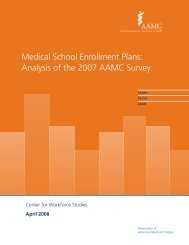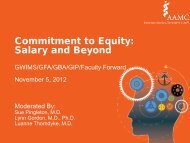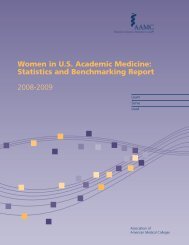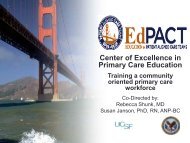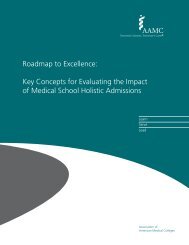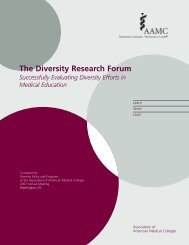Medical Students with Disabilities: A Generation of Practice
Medical Students with Disabilities: A Generation of Practice
Medical Students with Disabilities: A Generation of Practice
Create successful ePaper yourself
Turn your PDF publications into a flip-book with our unique Google optimized e-Paper software.
<strong>Medical</strong> <strong>Students</strong> <strong>with</strong> <strong>Disabilities</strong>:<br />
A <strong>Generation</strong> <strong>of</strong> <strong>Practice</strong><br />
Student A has average intellectual<br />
capability and an impairment<br />
(dyslexia) that limits his ability to<br />
learn so that he can only learn as<br />
well as ten percent <strong>of</strong> the population.<br />
His ability to learn is substantially<br />
impaired because it is limited in<br />
comparison to most people.<br />
Therefore, Student A has a disability<br />
for purposes <strong>of</strong> the ADA. By contrast,<br />
Student B has superior intellectual<br />
capability, but her impairment<br />
(dyslexia) limits her ability so that<br />
she can learn as well as the average<br />
person. Her dyslexia qualifies as an<br />
impairment. However, Student B’s<br />
impairment does not substantially<br />
limit the major life function <strong>of</strong><br />
learning, because it does not restrict<br />
her ability to learn as compared <strong>with</strong><br />
most people. Therefore, Student B is<br />
not a person <strong>with</strong> a disability for<br />
purposes <strong>of</strong> the ADA. 105<br />
The court in Price found the students to<br />
be similar to Student B in the above<br />
illustration. One student graduated from<br />
high school <strong>with</strong> a 3.4 grade point average,<br />
and from college <strong>with</strong> a 2.9 grade point<br />
average <strong>with</strong>out having received any<br />
accommodations. The student did<br />
receive accommodations on the <strong>Medical</strong><br />
College Admission Test (MCAT) and was<br />
subsequently admitted to medical school.<br />
The second student was a national honor<br />
student in high school, graduated from<br />
Virginia Military Institute <strong>with</strong> average<br />
grades, and maintained a 3.4 grade point<br />
average in courses required for admission<br />
to medical school. The student had not<br />
previously received any accommodations.<br />
The third student participated in a<br />
program for gifted students from<br />
elementary school through high school,<br />
graduated from high school <strong>with</strong> a 4.2<br />
grade point average, was admitted into<br />
the United States Naval Academy,<br />
graduated from Vanderbilt University,<br />
and was admitted to medical school, all<br />
<strong>with</strong>out accommodations. 106 The court<br />
ultimately concluded that although each<br />
student did have some learning difficulty,<br />
their overall history <strong>of</strong> significant<br />
scholastic achievement and the complete<br />
lack <strong>of</strong> evidence suggesting that they<br />
could not learn as well as the average<br />
person resulted in their not being entitled<br />
to accommodations under the ADA. 107<br />
A similar conclusion was reached in<br />
Gonzales v. National Board <strong>of</strong> <strong>Medical</strong><br />
Examiners. 108 In that case, Gonzales, a<br />
second year medical student, sought<br />
extra time on the United States <strong>Medical</strong><br />
Licensing Examination because <strong>of</strong> a<br />
learning disability. A series <strong>of</strong> cognitive<br />
tests, focusing on verbal ability, verbal<br />
expression, verbal comprehension,<br />
phonological processing, visual auditory<br />
learning, inductive reading, reading<br />
comprehension, and memory, indicated<br />
Gonzales’ scores were below average<br />
when compared <strong>with</strong> those <strong>of</strong> fourthyear<br />
college students; however, when<br />
compared to the general public, his<br />
scores were in the average to superior<br />
range. 109 The court held that the term<br />
“substantially limits” is to be interpreted<br />
as significantly restricting a major life<br />
activity in relation to the average person<br />
<strong>with</strong>in the population. 110<br />
<strong>Practice</strong> Tip: Merely having an impairment<br />
does not result in a student being disabled<br />
for purposes <strong>of</strong> the ADA or Section 504.<br />
<strong>Students</strong> <strong>with</strong> learning impairments must<br />
be substantially limited in their learning<br />
when compared <strong>with</strong> the general population.<br />
A learning impaired student is not<br />
considered disabled solely because he or<br />
she is substantially limited in the attempt<br />
to earn the medical doctor degree.<br />
D. Mitigating Measures<br />
Prior to 1999, courts followed the Equal<br />
Employment Opportunity Commission’s<br />
(EEOC) guidelines under which the existence<br />
<strong>of</strong> an impairment was considered<br />
<strong>with</strong>out regard to mitigating measures<br />
such as medicines or prosthetic devices.<br />
Thus, an individual <strong>with</strong> epilepsy was<br />
considered to have an impairment even<br />
if the symptoms were completely<br />
controlled by medicine. However, court<br />
opinions regarding the issue <strong>of</strong> mitigating<br />
measures have changed. Courts currently<br />
determine whether an individual’s<br />
impairment substantially limits a major<br />
life activity by considering the mitigating<br />
measures he or she employs. 111 An<br />
impairment which can be controlled or<br />
mitigated is no longer considered an<br />
impairment for purposes <strong>of</strong> the ADA or<br />
Section 504. The change in the treatment<br />
<strong>of</strong> mitigating measures came about in<br />
the landmark case <strong>of</strong> Sutton v. United<br />
Air Lines. 112 The Sutton case involved<br />
twin sisters <strong>with</strong> severe myopia who<br />
contended that the airline’s refusal to<br />
hire them as commercial pilots violated<br />
the ADA. The twins’ vision <strong>with</strong>out<br />
corrective measures was 20/200.<br />
However, <strong>with</strong> corrective lenses, their<br />
vision was 20/20. The airlines required<br />
uncorrected vision <strong>of</strong> at least 20/100.<br />
The Supreme Court found that myopia<br />
qualified as an impairment under the<br />
ADA, and that the impairment affected<br />
the major life activity <strong>of</strong> seeing.<br />
However, the Court determined that the<br />
twins were not substantially limited by<br />
their myopia, because corrective lenses<br />
mitigated the effects <strong>of</strong> the impairment.<br />
Consequently, the twins were not<br />
disabled for purposes <strong>of</strong> the ADA.<br />
105<br />
Id. at 427.<br />
106<br />
Id. at 422-23.<br />
107<br />
Id. at 427.<br />
108<br />
225 F. 3d 620 (6th Cir. 2000).<br />
109<br />
Id. at 628.<br />
110<br />
Id. at 631-32.<br />
111<br />
See Murphy v. United Parcel Serv., Inc., 119 S. Ct.<br />
2133 (1999); Sutton v. United Airlines, Inc., 119 S.<br />
Ct. 2139 (1999); Albertsons, Inc. v. Kirkinburg, 119<br />
S. Ct. 2162 (1999).<br />
112<br />
527 U.S. 471 (1999).<br />
13 Association <strong>of</strong> American <strong>Medical</strong> Colleges, 2005


